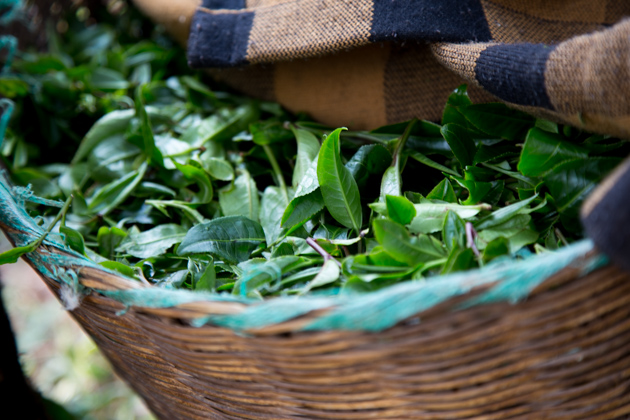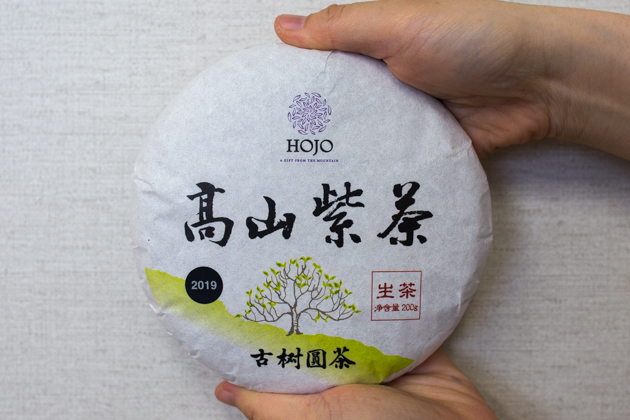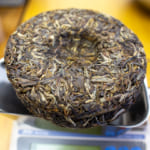- HOME >
- Types of Tea
High Mountain Pu-erh Tea is Now Available in Our Store
- [2019.10.19] Posted By Akira Hojo

High mountain purple raw pu-erh tea is now available in our store. This is one of the very interesting raw pu-erh teas we made in 2019.
High mountain tea called Zi-Cha
High mountain purple tea is made from the specific varietry called Zi-cha by the locals. In Chinese, Zi-cha means purple tea. This variety is different from the Zi Juan cultivar which is famous in South Yunnan. Zi Juan was vastly cultivated as garden tea in South Yunnan in recent years. Zi Juan cultivar gives astringent taste while the purple tea in Lincang gives very soft mouth-feel and easy drinking sensation.
The leaf and tree of purple tea looks like the normal tea tree. The only difference is the stem that is slightly reddish-purple. Once it is processed into raw pu-erh tea, it turns into dark navy colour.
The growing speed of the purple tea is slower than that of normal tea. This tea is only available close to the end of tea season when most of other teas has nearly finished.
Very rare tea in Yunnan
Most of the production area of purple tea is located at the high mountain area of Lincang. Generally, the altitude of its growing area is scattering at around 1900-2200m.
In fact, the purple tea is quite rare kind of tea in Yunnan. In particular, the old tea tree is extremely rare. Fortunately, our manufacturer happens to own the very old tea trees of purple tea. Those trees were grown by his ancestor. Before tea plucking season, we have booked all trees.


Dry fruity flavor
The purple tea variety gives unique fruity flavor if it is process in a proper way. However, very few people are aware that purple tea is flavorful. It is because of purple tea is too rare and less common. In addition, during frying process some tea manufacturers often spoil the tea due to improper handling. Thus, tea losses its flavorful characteristic and taste turns bitter.
In making our purple tea, we conducted series of trial and we have optimized the process to bring out the real characteristic. As a result, our high mountain purple tea gives thick fruity flavor that reminds me of dried mangoes, apricots or dates. I often think that the flavor of purple tea has a lot in common with Phoenix oolong too.

Naturally farmed tea at 2100m

This year we collected the fresh tea leaves of purple tea from the garden at about 2100-2200m. Thanks to the high altitude and the old age of tea tree, it gives very thick after taste and soft mouth-feel.
Another characteristic of purple tea is the strong body. It gives very bold and rich drinking sensation on palate.
Honey flavor produced by aging
The high mountain purple tea gives no bitterness and astringency. I personally love to drink it when it is freshly produced. However it is also suitable for further aging. In particular, after a few years of proper aging, this tea produces sweet flavor like fresh spring honey.
The price of high mountain purple tea is as follow.
Japan and Oversea Customer: 200g JPY4600
Malaysian Customer 200g RM188 and 357g RM330



Related Articles
How to get the latest update on HOJO?
1. Follow Twitter, 2. Click "Like" on Facebook, and 3. Subscribe in newsletter. You can have the latest tea news from HOJO.
 Subscribe the Newsletter to enjoy the privileges
Subscribe the Newsletter to enjoy the privileges- You may receive a free sample upon purchase, or you may have the priority to purchase special products. So please remember to subscribe our newsletter as well as the social network.
- New Arrival of Akitsu Mumyoi and Nosaka Rough Clay Teapot
- A wide selection of teaware by Watanabe Tozo, a Sado-based artist of Mumyoi-yaki, has just arrived. This time, …
- Mang Fei Ripe Pu-erh Tea 2023 – Small-Batch Production from a Renowned Region
- Mang Fei Ripe Pu-erh Tea 2023 is now available. This is one of the highest-quality ripe pu-erh teas among our …
NEW ARTICLES
 Development of Firewood Roasted Hojicha Using Naturally Grown Tea from Yunnan
Development of Firewood Roasted Hojicha Using Naturally Grown Tea from Yunnan- We are currently staying in Yunnan Province for tea production. As the season nears its end, tea trees with pa …
 Exploring the Food Culture of Yunnan: Where Minority and Sichuan Cuisines Meet
Exploring the Food Culture of Yunnan: Where Minority and Sichuan Cuisines Meet- We are currently staying long-term in Yunnan Province for spring tea production. On rainy days or when there i …
 New Arrival of Akitsu Mumyoi and Nosaka Rough Clay Teapot
New Arrival of Akitsu Mumyoi and Nosaka Rough Clay Teapot- A wide selection of teaware by Watanabe Tozo, a Sado-based artist of Mumyoi-yaki, has just arrived. This time, …
 Managing Yunnan White Tea — Insights from the Field
Managing Yunnan White Tea — Insights from the Field- Since March 25, we have been in Yunnan Province, fully engaged in the production of white tea. In this column, …
 Mang Fei Ripe Pu-erh Tea 2023 – Small-Batch Production from a Renowned Region
Mang Fei Ripe Pu-erh Tea 2023 – Small-Batch Production from a Renowned Region- Mang Fei Ripe Pu-erh Tea 2023 is now available. This is one of the highest-quality ripe pu-erh teas among our …
 Yunnan Tea Trends 2025: Insights from the Fields
Yunnan Tea Trends 2025: Insights from the Fields- Since March 25, we have been in Yunnan Province. We will stay here until May to conduct tea production, packin …
 Why Do Some Teas Taste Astringent? Exploring the Causes and Mechanisms of Astringency
Why Do Some Teas Taste Astringent? Exploring the Causes and Mechanisms of Astringency- Tea can range from having no noticeable astringency to possessing a very strong one. What causes this astringe …
 The Impact of Heat Sources on Tea Flavor
The Impact of Heat Sources on Tea Flavor- It is widely recognized that the material of a kettle plays an important role in shaping the taste of water fo …
 New Release of Tang Li Shan Ripe Pu-erh Tea 2023
New Release of Tang Li Shan Ripe Pu-erh Tea 2023- We have released the 2023 edition of Tang Li Shan Ripe Pu-erh Tea. Tang Li Shan refers to a mountain located o …
 The New Release of Dong Shan Raw Pu-erh Tea 2023 and Jasmine Silver Needle
The New Release of Dong Shan Raw Pu-erh Tea 2023 and Jasmine Silver Needle- We have released Dong Shan Raw Pu-erh Tea 2023 and Jasmine Silver Needle. Dong Shan Raw Pu-erh Tea 2023 We hav …
Category
- New Arrival at HOJO Online Shop
- Featured Articles
- Newsletter
- Types of Tea
- Origin of Tea
- Teapot and Tea Equipment
- Tea Column
- How to enjoy tea
- Tea Processing
- How to choose quality tea
- Tea constituents and functional effect
- Safety of Tea
- Foods
- Tea Business Operation
- Hobby and Outdoor Activity
- Ranking of Tea
- Video
- FAQ
- Media Release
Profile

- AKIRA HOJO
- I invite you to experience my tea selections.I was born in Nagano, Japan. In university, I studied agricultural chemistry, and I have the master degree in food science. I worked in Japanese food industry for 10 years. I involved in R&D, QC and QA. As a factory manager, I implemented ISO9000 series and managed the factory.
- The Art of Tea Magazine
- We posted the article on “The Art of Tea Magazine No.9, the magazine is published in Taiwan. We featured …
- New Straits Times
- The Malaysian National Newspaper, New Straits Times featured HOJO Tea on 17-Oct-2007.
Shop Info

Address:Lot No. T-215, 3rd Floor, The Gardens Mall, Mid Valley City, Lingkaran Syed Putra, 59200 Kuala Lumpur
Tel: +603-2287-4537
Business Hour: 10am to 10pm














